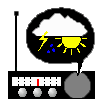
Do you have questions or comments about weather radio?
Use this link on the main NWS web site to submit your questions or comments.
National Weather Service Weather Radio (NWR) is a service that broadcasts on seven VHF Band frequencies ranging from 162.400 MHz to 162.550 MHz. These frequencies are outside the normal AM or FM broadcast bands found on the average home radio.
These broadcasts originate from local National Weather Service (NWS) offices across the United States. As the Voice of the National Weather Service, weather radio provides continuous broadcasts of the latest weather information. NWR is provided as a public service by the Department of Commerce's National Oceanic and Atmospheric Administration (NOAA). The NWR network has more than 900 stations in the 50 states and adjacent coastal waters, Puerto Rico, the U.S. Virgin Islands, and U.S. Pacific Territories. Broadcasts can be heard as far away as 40 miles from the antenna site. However, the effective range depends on several factors, including the terrain, quality of the receiver, and current weather conditions.
NWS Weather Radio provides dependable and timely weather information at your fingertips. From day-to-day weather forecasts to warnings of deadly storms, NWR is always available, 24 hours a day, 365 days a year. The broadcast schedule consists of messages which are repeated every 5-15 minutes and are routinely revised to provide up-to-date information.
During severe weather or other potentially hazardous events, the regularly scheduled programming is interrupted to substitute severe weather (including warnings, watches, etc.) or other hazardous informational messages. Special NWR receivers can be activated, sounding an alarm indicating that important information soon follows. Tests of the warning alarm are normally conducted by NWS Mount Holly every Wednesday around 11:30 am local time.
NWR can also be used to alert you to non-weather related emergencies, such as earthquakes, toxic or chemical spills, national attacks, or nuclear blasts. Many local retailers or electronics stores sell NWS Weather Radios. To purchase a NOAA All Hazards Weather Radio, check with your local electronics shop or check out our NWR Receiver Consumer Information page. Please see either this national FAQ webpage or this PHI FAQ webpage for more information.
The National Weather Service encourages everyone to use weather radio to receive life-saving warnings and other information from the National Weather Service in Mount Holly. The warning alarm precedes tornado and severe thunderstorm watches, and tornado, severe thunderstorm, and flash flood warnings, as well as other emergency messages, and is designed to activate specially designed weather radio receivers, providing audible and/or visual warning signals to homes, schools, and businesses in the path of the storm.
Local 7 Day Forecast - Valid for the NWS Weather Radio listening area.
Coastal and Offshore Waters Forecast - Valid for the NWS Weather Radio listening areas adjacent to and covering the coastal waters of New Jersey and Delaware, Delaware Bay, and Chesapeake Bay.
Hourly Weather Roundup - Summarizes current weather conditions for cities in eastern Pennsylvania, northeastern Maryland, Delaware, and New Jersey.
Regional Weather Synopsis - A brief description of the expected weather pattern for the region for the next 7 days.
Surf Zone Forecast - Forecasts of rip current risk, surf heights, water temperatures, and weather conditions for the beaches of New Jersey and Delaware.
Climate Information - Includes temperatures and rainfall, climatological normals, and accumulations for several locations within the NWS Mount Holly forecast area.
Severe Weather Watches, Warnings, and Statements - Important information regarding the location and movements of severe thunderstorms, including damaging winds, large hail, and/or tornadoes.
Flood/Flash Flood Watches, Warnings, and Statements - Important information regarding the location and movement of heavy rain and flash flood producing thunderstorms and weather systems.
Tropical/Storm Surge Watches, Warnings, and Statements - Important information regarding any potential tropical systems forecast to affect the NWS Mount Holly forecast area.
Winter Weather Watches, Warnings, and Advisories - Important information regarding potential hazardous winter weather.
Coastal Flood Watches, Warnings, Advisories, and Statements - Important information regarding any potential tidal flooding affecting the Atlantic coast of New Jersey and Delaware, the shoreline of Delaware Bay, the eastern shore of Chesapeake Bay, the tidal portions of the Delaware River, and tidal tributaries to any of the aforementioned areas.
Non-Precipitation Warnings and Advisories - Important information regarding potentially hazardous weather conditions not associated with precipitation, such as wind chill, heat, non-thunderstorm high winds, fog, frost, and freezes.
New technology is now available in NWS Weather Radio that allows you to obtain only the warnings, watches, and other information you want.
This technology, called the Specific Area Message Encoder (SAME), broadcasts the same information we always have had, but adds a code that enables specially built receivers to receive only the information you want. Thus, you can receive severe weather warnings, watches, and statements for the only county in which you live, if desired, and not information for other counties in the overall NWR broadcast area.
All current and older model NWR receivers will receive all information from the NWS, but only radios with the SAME capability can be programmed to receive information for specific counties.
These new receivers are available at local electronics stores in your area. If you have purchased a new weather radio with the SAME capability and want to program it for specific counties in your NWR listening area, you will need the proper county codes (FIPS).
NWR SAME County Codes
Use these links to report a transmitter problem: